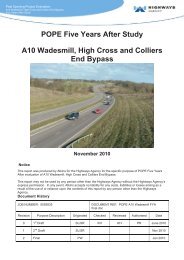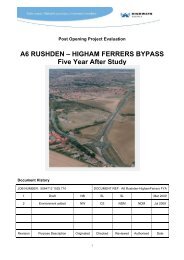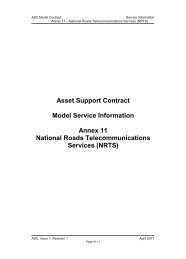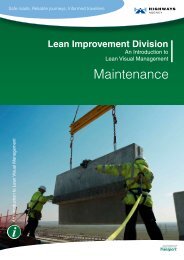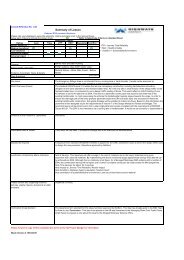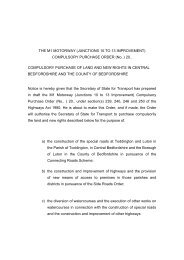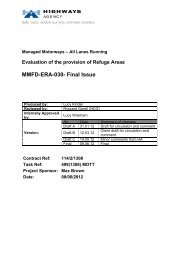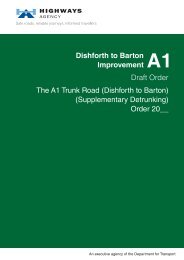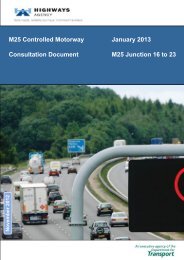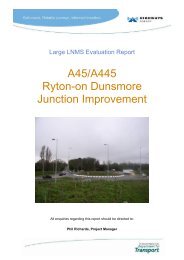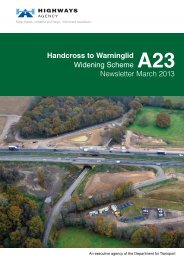Highways Agency Annual Report and Accounts 2011-2012
Highways Agency Annual Report and Accounts 2011-2012
Highways Agency Annual Report and Accounts 2011-2012
You also want an ePaper? Increase the reach of your titles
YUMPU automatically turns print PDFs into web optimized ePapers that Google loves.
SECTION 10: Financial Statements<br />
ended 31 March 2010. In addition during the year ending 31 March <strong>2012</strong> the <strong>Agency</strong> has reviewed the<br />
specific methodology for valuing structures, moving to a simpler categorisation of structure types <strong>and</strong> the<br />
application of st<strong>and</strong>ard road dimensions (rather than individual structure dimensions) where possible.<br />
Information on infrastructure assets is held on a number of operational asset management systems.<br />
Where appropriate, dimensional data is used from these systems to inform the valuation of individual<br />
roads <strong>and</strong> structures. The application of professional judgement by engineers will impact the variability of<br />
dimensional data which in turn will impact the valuation of the infrastructure asset.<br />
Indexation<br />
Various indices are applied to the valuation of the network to ensure the final valuation is at current<br />
replacement cost. Indexation of the network valuation is applied as follows:<br />
Indexation<br />
Roads <strong>and</strong><br />
structures<br />
Roads <strong>and</strong><br />
structures<br />
L<strong>and</strong><br />
Technology<br />
Five year revaluation<br />
Year end revaluation<br />
Unit costs are calculated from projects opened to traffic over the<br />
last 5-10 years to value carriageways, structures <strong>and</strong> technology.<br />
Unit rates from projects with different opening dates are brought to<br />
a common baseline using Roadcon, a construction industry index.<br />
This index is calculated from tenders for highway works <strong>and</strong> reflects<br />
contractor’s output costs.<br />
ROCOS is the index applied to roads <strong>and</strong> structures for yearly<br />
revaluation <strong>and</strong> reflects the movement in prices in the construction<br />
industry. ROCOS (resource cost index of road construction); published<br />
on a quarterly basis by the Department for Business, Innovation<br />
<strong>and</strong> Skills (BIS).<br />
L<strong>and</strong> indices published twice yearly by the Valuation Office <strong>Agency</strong><br />
(VOA).<br />
ROCOS is the index applied to all technology assets.<br />
Indexation based on these indices is applied to all elements of the network. However there may be<br />
occasions where the use of indices for particular network assets may give an unrealistic outcome. This<br />
may happen for example where there has been substantial technological change when changes in the<br />
cost of specific assets are known to have been significantly different from the changes in the index;<br />
or where the historical purchase cost of assets was affected by special circumstances unlikely to be<br />
repeated <strong>and</strong> for which no allowance can be made. In such circumstances the gross current replacement<br />
cost is based on expert opinion or other evidence of the current cost of assets or groups of assets having<br />
a similar service potential.<br />
The valuation of the network is based upon a non recoverable VAT rate of 20% which reflects a consistent<br />
long-term approach to valuing the network. Certain special structures are valued at historic prices<br />
appropriately indexed as the best approximation of replacement cost.<br />
Assets Under Construction<br />
All new projects in the course of design or construction are accounted for as assets under construction<br />
(AUC) at their actual build cost. On completion of a project, the project is transferred out of AUC <strong>and</strong> into<br />
Infrastructure Assets at the current replacement cost (which will be different from the actual cost).<br />
The difference between a project’s actual cost of construction <strong>and</strong> the current replacement cost is treated<br />
as a write down which is charged to the Statement of Comprehensive Net Expenditure (SCNE).<br />
Write-downs<br />
Write-downs arise due to the difference between the cost of construction <strong>and</strong> the current st<strong>and</strong>ard<br />
replacement costs. There are a number of reasons for this difference in cost including:<br />
<strong>Highways</strong> <strong>Agency</strong> <strong>Annual</strong> <strong>Report</strong> <strong>and</strong> <strong>Accounts</strong> <strong>2011</strong>-12



